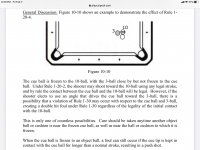Let Newton solve your problem
You won't normally find specific situations like your OP in rule sets because the variables of ball position and the action of the cue stick as wielded by the player are virtually infinite and definitely unpredictable. To write a rule covering every possible position is impossible, and to write a thousand rules covering the most common possible results in impractical.
The closest a rule set can come to assisting in the understanding of the situation is to slightly clarify and explain double hit dangers of nearby OB's (and cushions), an example of which is the material I wrote for CSI as quoted above from CSI AR 1-20/1-30 General Discussion. What is NOT unpredictable is the actions of the balls given certain collisions occurring. It is up to officials themselves and the organizations that employ them to ensure they are properly trained in the techniques to analyze the action of the balls in order to determine whether a double hit occurred. Unfortunately that training is frequently severely questionable.
Regarding your specific quoted situation, in which the nearby additional OB is on (or very near) the line of centers through the CB and frozen OB, the call is ridiculously easy for any properly trained official. Just let Newton's third law do the work for you.
By CSI and WSR rule, it is legal to shoot toward the frozen OB. If that shot is executed on or nearly along the line of centers, there will be two balls worth of energy entering the collision with the nearby non-frozen OB. Therefore, according to the laws of physics, two - and ONLY two - balls worth of energy may leave that collision unless acted upon by some other force. Just like Newton's Cradle...two balls in, two balls out.
So in a legal hit the CB and the frozen OB are the two balls in, and the frozen OB and the nearby non-frozen OB are the two balls out. The frozen OB and the non-frozen OB will will proceed along the line of the shot at nearly the same speed, while the CB must either stop (if skidding), or stop briefly and then continue ahead or back at a (probably) much slower speed than the OB's if there is significant spin applied to the vertical center of the CB during the stroke.
If the CB moves down the table along with the OB's at nearly the same speed, or if the CB, with reverse spin, skids forward of the position of the frozen OB where it contacts the nearby non-frozen OB, then it is virtually certain there has been a double hit. There could conceivably be some extraneous wacky factors such as extra heavy CB's (mud balls) that might vary results slightly, but in almost any reputable competition with decent equipment the analysis is reliable to the point of certainty for a properly trained official that is paying attention.
That analysis is a safe bet if the setup is close to the line of centers. If the nearby OB is off the line of centers of the CB/frozen OB, it's a little tougher to make the analysis, but not all that bad. You just have to apply the right angle rule to the collision between the CB and non-frozen OB (if any), and ignore the frozen OB. If the non-frozen ball is off the line of centers and there is no collision between the CB and non-frozen ball, a good hit at almost any speed is a virtual certainty.
Buddy

![CropperCapture[456].png CropperCapture[456].png](https://forums.azbilliards.com/data/attachments/400/400224-4a3275c9230771bff1038855322aeb9b.jpg)